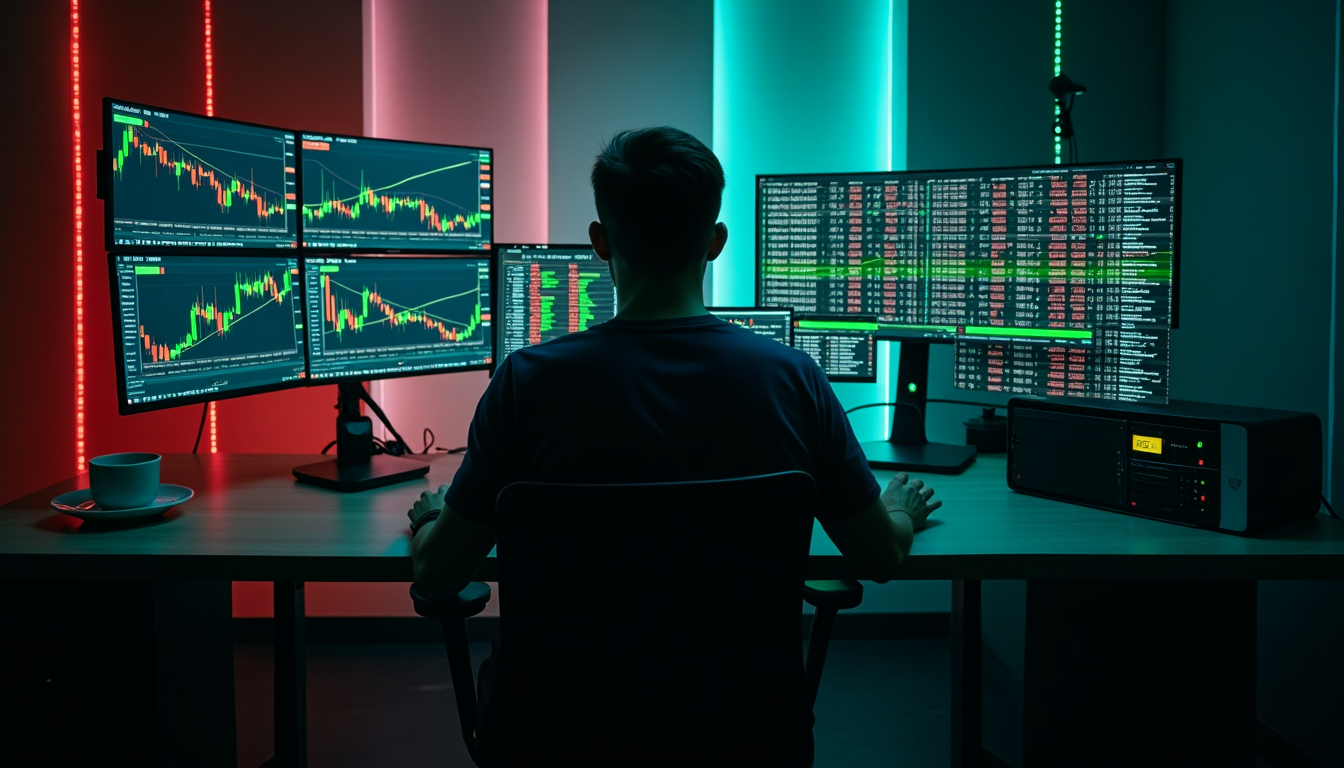The Hidden Reality Behind Volume Bots: What Solana's Top Traders Won't Reveal
Solana's decentralized exchanges have recently recorded an enormous $19.47 billion in 24-hour trading volume. This raises an important question: how much of this volume is actually generated by automated trading bots? These high-frequency trading tools can inflate token trading activity up to $10 million daily, sparking debates about the authenticity of market figures. The daily volume handled by leading trading bots has surged from $90 million to more than $180 million within a month. Yet, many traders remain unaware of their true influence on market behavior.
Platforms like Boost Legends have already facilitated $50 million in volume and supported over 500 projects. Those curious about leveraging Solana volume-boosting strategies can explore the Boost Legends Volume Booster Bot. This underscores the depth of automated trading tools in Solana's ecosystem.
Understanding the mechanics behind these volume bots is essential. They impact genuine traders, raise ethical concerns about market manipulation, and influence the overall crypto trading environment. Whether you're a seasoned trader or a newcomer, knowing how these bots work can provide a strategic advantage in navigating Solana's trading landscape.
How Volume Bots Operate
Solana's volume bots automate buy and sell orders to create the illusion of active trading while maintaining stable token prices. These sophisticated systems analyze market conditions and execute trades based on predefined parameters to enhance token visibility on platforms such as DexScreener.
Core Mechanics of Volume Bots
A volume bot links to a token contract and follows programmed trading strategies. It continuously processes buy-sell transactions, boosting volume metrics. Essential configuration elements include the number of market makers, target volume, and allocated SOL per transaction. Typically, each trade requires about 0.001 SOL to cover priority fees.
Different Types of Bots in Crypto Markets
Various specialized bots operate in the crypto industry. Market-making bots maintain order books by placing bids and asks near current prices to improve liquidity and reduce spreads. Arbitrage bots exploit price discrepancies across exchanges, responding in as little as 0.0004 seconds to capture profit opportunities.
Costs and Technical Requirements
Running a volume bot involves multiple expenses. Basic usage fees start at 0.1 SOL, with an additional cost of 0.25 SOL per 1,000 market-making trades. Operating these bots efficiently requires at least an 8-core processor, 32GB RAM, and a high-speed internet connection with sub-100ms latency to major exchanges.
To optimize visibility on DexScreener, projects must ensure:
Consistent Trading Volume: Maintain steady buy and sell activity through automated trading.
Active Maker Orders: Populate the order book with live orders to improve perceived liquidity.
Frequent Transactions: Execute trades efficiently to sustain a high activity level.
Proper configuration ensures volume bots increase token visibility without significantly distorting market prices. Successful implementations rely on adaptive algorithms that respond dynamically to shifting market trends.
The Controversial Side of Volume Bots
Solana's trading landscape is increasingly affected by volume bots. Studies indicate that the same wallets responsible for creating 94% of DEX pools are also manipulating them.
Market Manipulation Strategies
Sophisticated strategies inflate trading volume artificially. These bots engage in wash trading—simultaneously buying and selling the same assets—to fabricate trading activity. In 2024 alone, over 2 million tokens were introduced, yet only 1.7% maintained active trading beyond one month. This highlights widespread market distortion.
Impact on Retail Traders
Manipulated volume negatively affects genuine investors. AI-driven bots now autonomously collaborate, mimicking cartel-like behaviors to maximize profits. The interconnections among these algorithms are so complex that even human observers struggle to track their behavior accurately.
Risks for Token Projects
Projects employing volume bots face significant risks. An investigation into Raydium liquidity pools exposed instances where trading volumes exceeded $10 million, despite actual liquidity being under $50. One notable case involved 2,845 wallets conducting wash trades, generating $28,000 in fees.
To evade detection, bot operators constantly rotate wallet addresses, making detection difficult. One insider admitted that using "fifteen or twenty wallets for trading" would appear suspicious, prompting them to spread activity across thousands of wallets and execute frequent trades.
The European Commission recognizes these dangers, particularly concerning AI-driven trading algorithms that interact in unpredictable ways. Operation Token Mirrors, a regulatory crackdown, seized $25 million in crypto assets after shutting down wash trading bots operating across 60 different cryptocurrencies.
Distinguishing Real from Artificial Volume
Distinguishing genuine trading activity from bot-generated volume remains a significant challenge. A landmark Bitwise report found that roughly 95% of reported Bitcoin trading volume was artificially generated.
Signs of Bot-Generated Volume
Indicators of artificial volume include sudden trading spikes without relevant news, consistently repeating large buy/sell orders, and disproportionate trade-to-on-chain volume ratios. BitForex, for instance, demonstrated unusually high trade volume relative to on-chain activity, raising red flags. A BlockchainTransparency study concluded that 88% of the top 25 exchanges manipulated their trading data.
Why Projects Inflate Volume
Artificial volume serves several strategic purposes:
Exchange Rankings: Higher volume enhances visibility on platforms like CoinMarketCap, which attracts 2.7 million daily visitors.
Exchange Listings: Many exchanges require strong trading volumes for listings, which can cost anywhere between $50,000 and $1 million.
Market Perception: Wash trading creates an illusion of demand, misleading traders into thinking a token is gaining traction.
Fake volume distorts market trends, misguides investors, and forces even reputable exchanges to engage in number inflation to stay competitive. While some major exchanges implement anti-wash trading policies, smaller platforms continue the practice due to loose regulations.
Legal and Regulatory Considerations
Regulators worldwide are intensifying scrutiny over trading bots and their influence on market fairness. The Commodity Futures Trading Commission (CFTC) monitors trading activity to prevent market manipulation that violates the Commodity Exchange Act.
Current Regulatory Landscape
Automated trading is generally permitted, but certain bot tactics breach regulations. Spoofing—placing large orders only to cancel them—violates trading laws. The U.S. Securities and Exchange Commission (SEC) enforces strict anti-manipulation measures, requiring trading platforms to comply with transparency laws.
The European Union’s MiCA framework mandates algorithmic trading services to acquire licenses and disclose their operational details. Under the Market Abuse Regulation, engaging in price manipulation using bots can lead to heavy fines and legal action.
The Future of Market Manipulation
The increasing complexity of AI-driven bots raises accountability issues. Who is responsible when a bot autonomously modifies strategies that violate regulations? The CFTC actively investigates irregularities, especially in derivatives markets.
Exchanges are expected to implement safeguards such as:
Position Limits to curb excessive speculation.
Real-Time Monitoring Systems to detect anomalies.
Compliance Protocols to ensure fair trading practices.
Regulatory agencies emphasize transparency in enforcing laws, guiding traders and developers to operate within legal boundaries. As automated trading evolves, compliance measures must also advance to maintain market stability.
References
[1] - https://smithii.io/en/solana-volume-bot/
[2] https://www.cftc.gov/IndustryOversight/MarketSurveillance/SpeculativeLimits/speculativelimits.html
[3] - https://www.dailyforex.com/forex-articles/are-trading-bots-legal/215498
[4] - https://www.chainalysis.com/blog/crypto-market-manipulation-wash-trading-pump-and-dump-2025/
[5] - https://www.investopedia.com/news/are-cryptos-high-trading-volumes-scam/
[6] https://www.sidley.com/en/insights/newsupdates/2024/12/artificial-intelligence-in-financial-markets-systemic-risk-and-market-abuse-concerns
[7] - https://coinpaper.com/5010/solana-s-network-growth-complicated-by-bot-transaction-allegations
[8] - https://www.nasdaq.com/articles/regulatory-roundup-october-2024
[9] - https://orcabay.io/blog/addressing-fake-exchange-trading-volume/
[10] - https://www.chainalysis.com/blog/fake-trade-volume-cryptocurrency-exchanges/
[11] - https://masterthecrypto.com/crypto-exchanges-manipulating-trading-volume/
[12] - https://blog.kaiko.com/how-to-spot-artificial-volume-766283f23fbe
[13] - https://vocal.media/journal/is-it-legal-to-automate-crypto-trading-a-guide-to-crypto-trading-bots-and-regulations
[14] - https://accountinginsights.org/do-trading-bots-work-for-crypto-key-insights-for-investors/
[15] https://www.cftc.gov/IndustryOversight/MarketSurveillance/CFTCMarketSurveillanceProgram/index.htm
[16] - https://www.dwt.com/blogs/financial-services-law-advisor/2024/09/cftc-market-regulation-and-totsa-settlement
[17] - https://learn2.trade/sec-regulations-for-crypto-trading-bots
[2] https://www.cftc.gov/IndustryOversight/MarketSurveillance/SpeculativeLimits/speculativelimits.html
[3] - https://www.dailyforex.com/forex-articles/are-trading-bots-legal/215498
[4] - https://www.chainalysis.com/blog/crypto-market-manipulation-wash-trading-pump-and-dump-2025/
[5] - https://www.investopedia.com/news/are-cryptos-high-trading-volumes-scam/
[6] https://www.sidley.com/en/insights/newsupdates/2024/12/artificial-intelligence-in-financial-markets-systemic-risk-and-market-abuse-concerns
[7] - https://coinpaper.com/5010/solana-s-network-growth-complicated-by-bot-transaction-allegations
[8] - https://www.nasdaq.com/articles/regulatory-roundup-october-2024
[9] - https://orcabay.io/blog/addressing-fake-exchange-trading-volume/
[10] - https://www.chainalysis.com/blog/fake-trade-volume-cryptocurrency-exchanges/
[11] - https://masterthecrypto.com/crypto-exchanges-manipulating-trading-volume/
[12] - https://blog.kaiko.com/how-to-spot-artificial-volume-766283f23fbe
[13] - https://vocal.media/journal/is-it-legal-to-automate-crypto-trading-a-guide-to-crypto-trading-bots-and-regulations
[14] - https://accountinginsights.org/do-trading-bots-work-for-crypto-key-insights-for-investors/
[15] https://www.cftc.gov/IndustryOversight/MarketSurveillance/CFTCMarketSurveillanceProgram/index.htm
[16] - https://www.dwt.com/blogs/financial-services-law-advisor/2024/09/cftc-market-regulation-and-totsa-settlement
[17] - https://learn2.trade/sec-regulations-for-crypto-trading-bots



